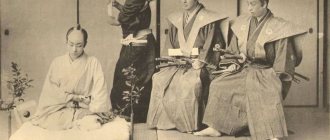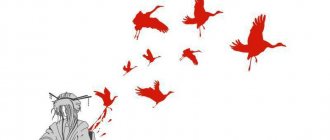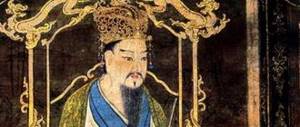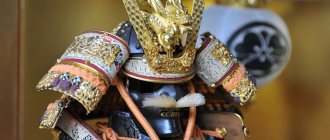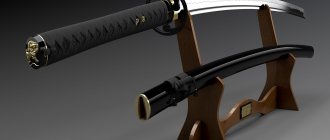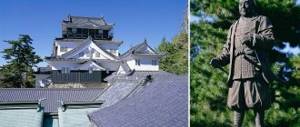Japanese samurai are known, perhaps, all over the world. They are sometimes compared to European knights, but this comparison is not entirely accurate. From Japanese, the word "samurai" is translated as "a person who serves." Medieval samurai for the most part were noble and fearless fighters, fighting against enemies with the help of katanas and other weapons. But when did they appear, how did they live in different periods of Japanese history, and what rules did they follow? About all this in our article.
The origins of the samurai as a class
Samurai appeared as a result of the Taika reforms that started in the Land of the Rising Sun in 646. These reforms can be called the largest socio-political transformations in the history of ancient Japan, which were carried out under the leadership of Prince Naka no Oe.
Emperor Kammu gave a big impetus to strengthening the samurai at the beginning of the ninth century. This emperor turned to existing regional clans for help in his war against the Ainu, another people who lived on the islands of the Japanese archipelago. By the way, there are only a few tens of thousands of Ainu left now.
Japanese Emperor Kammu
In the 10th–12th centuries, in the process of “showdowns” between feudal lords, influential families were formed. They had their own fairly substantial military detachments, the members of which were only nominally in the service of the emperor. In fact, every major feudal lord then needed well-trained professional warriors. They became the samurai. During this period, the foundations of the unwritten samurai code “The Way of the Bow and the Horse” were formed, which was later transformed into a clear set of rules “The Way of the Warrior” (“Bushido”).
Books dedicated to the principles of Bushido are still being published, including in Russian.
Samurai in the Minamoto and Edo eras
The final formation of the samurai as a special privileged class occurred, according to most researchers, during the reign of the Minamoto house in the Land of the Rising Sun (this is the period from 1192 to 1333). The accession of Minamoto was preceded by a civil war between feudal clans. The very course of this war created the preconditions for the emergence of the shogunate - a form of government with a shogun (that is, a military leader) at the head.
After the Taira clan was defeated, Minamoto no Yoritomo forced the emperor to give him the title of shogun (thus becoming the first shogun), and he made the small fishing settlement of Kamakura his own residence. Now the shogun was the most powerful person in the country: the highest-ranking samurai and the chief minister at the same time. Of course, official power in the Japanese state belonged to the emperor, and the court also had some influence. But the position of the court and the emperor still could not be called dominant - for example, the emperor was constantly forced to follow the instructions of the shogun, otherwise he would be forced to abdicate the throne.
Yoritomo established a new governing body for Japan, called the "field headquarters." Like the shogun himself, almost all of his ministers were samurai. As a result, the principles of the samurai class spread to all areas of Japanese society.
Minomoto no Yorimoto - the first shogun and the highest-ranking samurai of the late 12th century
The "golden age" of samuraiism is considered to be the period from the first shogun to the Onin Civil War (1467–1477). On the one hand, it was a fairly peaceful period, on the other, the number of samurai was relatively small, which allowed them to have good income.
Then in the history of Japan there came a period of many internecine wars, in which samurai took an active part.
Large-scale samurai battles were common during the era of civil strife.
In the mid-16th century, there was a feeling that the empire, shaken by conflicts, would forever fall apart into separate parts, but the daimyo (prince) from the island of Honshu, Oda Nobunaga, managed to start the process of unifying the state. This process was long, and only in 1598 was true autocracy established. Tokugawa Ieyasu became the ruler of Japan. He chose the city of Edo (present-day Tokyo) as his residence and became the founder of the Tokugawa shogunate, which ruled for more than 250 years (this era is also called the Edo era).
With the rise of the Tokugawa house to power, the class of samurai increased significantly - almost every fifth Japanese became a samurai. Since internal feudal wars were a thing of the past, samurai military units at this time were used mainly to suppress peasant uprisings.
Ieyasu Tokugawa - founder of the Tokugawa shogunate
The most senior and important samurai were the so-called hatamoto - direct vassals of the shogun. However, the bulk of the samurai performed the duties of vassals of the daimyo, and most often they did not have land, but received a certain salary from their master. At the same time, they had quite great privileges. For example, Tokugawa legislation allowed a samurai to kill on the spot a “commoner” who behaved indecently without any consequences.
There is a misconception that all samurai were fairly wealthy people. But that's not true. Already under the Tokugawa shogunate, there were poor samurai who lived not much better than ordinary peasants. And in order to feed their families, some of them still had to cultivate the land.
17th century samurai: figurine
In my father's footsteps
Samurai with a child. (Pinterest)
Lands and class affiliation were passed on from father to son. If a samurai died, his eldest son became the head of the family, even if by that time he was still a child. At the barely conscious age of 10-12 years, such young samurai already had the right to make fateful decisions, although they still had several years left before completing their education (usually they completed the bulk of their training at the age of 15).
Young samurai could already serve their daimyo - for example, carry out daily errands or occupy positions in a rich house such as “caretaker” of a valuable item, “supplier of water in the morning,” etc.
Certain clans (such as the Minamoto, Taira and Fujiwara) ruled Japan for centuries, and were in turn served by dozens of other clans.
The samurai held so tightly to the cause and way of life of their ancestors that when Japan in the 19th century. modernization was needed, it was necessary to dismantle the conservative samurai system in general through the “Meiji Revolution” and long painful reforms.
Education and code of the samurai
When raising future samurai, they tried to instill in them indifference to death, physical pain and fear, a cult of respect for elders and loyalty to their master. The mentor and family primarily focused on developing the character of the young man who took this path, developing in him courage, endurance and patience. Character was developed by reading stories about the exploits of heroes who glorified themselves as samurai of the past, and by watching relevant theatrical productions.
Sometimes the father ordered the future warrior, in order to become bolder, to go alone to a cemetery or other “bad” place. It was common practice for teenagers to attend public executions, and they were also sent to examine the bodies and heads of dead criminals. Moreover, the young man, the future samurai, was obliged to leave a special sign that would prove that he was not shirking, but was actually here. Often, future samurai were forced to do hard work, spend sleepless nights, walk barefoot in winter, etc.
Training of the future samurai (still from the 2003 film “The Last Samurai”)
It is known for certain that samurai were not only fearless, but also very educated people. The Code of Bushido, which was already mentioned above, stated that a warrior must improve himself by any means. And therefore, the samurai did not shy away from poetry, painting and ikebana, they studied mathematics, calligraphy, and held tea ceremonies.
Zen Buddhism also had a huge influence on the samurai class. It came from China and spread throughout Japan at the end of the 12th century. Samurai found Zen Buddhism as a religious movement very attractive, as it contributed to the development of self-control, will and composure. In any situation, without unnecessary thoughts or doubts, the samurai had to go straight to the enemy, without looking back or to the side, in order to destroy him.
Many samurai actively used Buddhist meditation practices
Another interesting fact: according to Bushido, the samurai was obliged to carry out the orders of his master unquestioningly. And even if he ordered to commit suicide or go with a detachment of ten people against an army of a thousand, this had to be carried out. By the way, the feudal lords sometimes gave the order to the samurai to go to certain death, to battle with an enemy superior in numbers, just to get rid of him. But one should not think that samurai never passed from master to master. This often happened during skirmishes between small feudal lords.
The worst thing for a samurai was to lose honor and cover himself with shame in battle. They said about such people that they were not even worthy of death. Such a warrior wandered around the country and tried to earn money like an ordinary mercenary. Their services were used in Japan, but they were treated with disdain.
One of the most shocking things associated with samurai is the ritual of hara-kiri or seppuku. A samurai had to commit suicide if he was unable to follow Bushido or was captured by his enemies. And the ritual of seppuku was considered an honorable way to die. It is interesting that the components of this ritual were a ceremonial bath, a meal with the most favorite food, and the writing of the last poem - tank. And next to the samurai performing the ritual, there was always a faithful comrade, who at a certain moment had to cut off his head in order to stop the torment.
Feudal hierarchy
The samurai class has always been distinguished by a strict hierarchy. At the very top of these stairs was the shogun. Next came the daimyo. These were the heads of the most important and powerful families in Japan. If the shogun died without leaving an heir, then his successor was chosen from among the daimyo.
At the middle level were feudal lords who owned small estates. Their approximate number fluctuated around several thousand people. Next came the vassals of vassals and ordinary soldiers without property.
At its peak, the samurai class made up about 10% of the total population of Japan. Members of their families can also be included in this layer. In fact, the power of the feudal lord depended on the size of his estate and the income from it. It was often measured in rice, the main food of the entire Japanese civilization. The soldiers were also paid with literal rations. For such “trade” there was even a system of weights and measures. Koku was equal to 160 kilograms of rice. Approximately this amount of food was enough to satisfy the needs of one person.
To understand the value of rice in medieval Japan, it is enough to give the example of a samurai salary. Thus, those close to the shogun received from 500 to several thousand koku of rice per year, depending on the size of their estate and the number of their own vassals, who also needed to be fed and supported.
Appearance, weapons and armor of the samurai
What medieval samurai looked like is reliably known from many sources. Over the course of many centuries, their appearance has remained almost unchanged. Most often, samurai wore wide trousers, reminiscent of a skirt in cut, with a bun of hair on their heads called motodori. For this hairstyle, the forehead was shaved bald, and the remaining hair was braided into a knot and secured on the top of the head.
This photo clearly shows the traditional samurai hairstyles
As for weapons, samurai have used different types throughout their long history. Initially, the main weapon was a thin short sword called a chokuto. Then the samurai switched to curved swords, which eventually transformed into the katanas known throughout the world today. In the Bushido code it was said that the soul of a samurai is contained in his katana. And it is not surprising that this sword was considered the most important attribute of a warrior. As a rule, katanas were used in conjunction with a daisho, a short copy of the main sword (daisho, by the way, only samurai had the right to wear - that is, it was an element of status).
In addition to swords, samurai also used bows, since with the development of warfare, personal courage and the ability to fight the enemy in close combat began to matter much less. And when gunpowder appeared in the 16th century, bows gave way to firearms and cannons. For example, flintlock guns called tanegashima were popular in the Edo era.
Samurai with a gun
On the battlefield, samurai wore special armor - armor. This armor was luxuriously decorated and looked somewhat ridiculous, but each part had its own specific function. The armor was both durable and flexible, allowing its owner to move freely on the battlefield. The armor was made of metal plates tied together with leather and silk laces. The arms were protected by rectangular shoulder shields and armored sleeves. Sometimes such a sleeve was not worn on the right hand to make fighting easier.
An integral element of the armor was Kabuto's helmet. Its cup-shaped part was made of metal plates connected with rivets. An interesting feature of this helmet is the presence of a balaclava (exactly like Darth Vader from Star Wars). It protected the owner's neck from possible blows from swords and arrows. Along with helmets, samurai sometimes wore gloomy Mengu masks to intimidate the enemy.
Samurai in armor
In general, this combat clothing was very effective, and the United States Army, as experts say, created the first body armor based on medieval Japanese armor.
The origin of the class
Approximately in the 18th century, the same warriors appeared whose successor is any samurai. Japanese feudalism arose from the Taika reforms. The emperors resorted to the help of samurai in their fight against the Ainu, the indigenous inhabitants of the archipelago. With each new generation, these people, who faithfully served the state, acquired new lands and money. Clans and influential dynasties were formed that owned significant resources.
Around the X-XII centuries. In Japan, a process similar to the European one took place - the country was rocked by internecine wars. Feudal lords fought against each other for lands and wealth. At the same time, imperial power remained, but it was extremely weakened and could not prevent civil confrontation. It was then that the Japanese samurai received their code of rules - bushido.
Casual wardrobe
In the life of a samurai, almost everything was regulated - from relationships with others to clothing. It was also a social marker by which aristocrats distinguished themselves from peasants and ordinary townspeople. Only samurai could wear silk clothes. In addition, their things had a special cut. A kimono and hakama were required. Weapons were also considered part of the wardrobe. The samurai always carried two swords with him. They were tucked into a wide belt.
Only aristocrats could wear such clothes. Peasants were prohibited from wearing such a wardrobe. This is also explained by the fact that on each of his things the warrior had stripes that showed his clan affiliation. Every samurai had such coats of arms. Translating the motto from Japanese could explain where it came from and who it served.
Samurai could use any available item as a weapon. Therefore, the wardrobe was also selected for possible self-defense. The samurai fan became an excellent weapon. It differed from ordinary ones in that the basis of its design was iron. In the event of a surprise attack by enemies, even such an innocent thing could cost the lives of the attacking enemies.
Military honor
In the Middle Ages, every resident of the country knew the names of Japanese samurai, since they were the state and military elite. Few who wished to join this class could do so (either because of their ugliness or because of inappropriate behavior). The closed nature of the samurai class lay precisely in the fact that strangers were rarely allowed into it.
Clanism and exclusivity greatly influenced the norms of behavior of warriors. For them, their own dignity was the most important thing. If a samurai brought shame on himself by an unworthy act, he had to commit suicide. This practice is called harakiri.
Every samurai had to be responsible for his words. The Japanese code of honor required people to think several times before making any statement. Warriors were required to eat moderately and avoid promiscuity. A true samurai always remembered death and reminded himself every day that sooner or later his earthly journey would end, so the only important thing was whether he was able to maintain his own honor.
Samurai philosophy
The Japanese samurai warrior was raised in bushido. He had to strictly follow all the prescribed rules. These norms applied to both public service and personal life.
The popular comparison of knights and samurai is incorrect precisely from the point of view of comparing the European code of honor and the rules of bushido. This is due to the fact that the behavioral foundations of the two civilizations were extremely different from each other due to isolation and development in completely different conditions and societies.
For example, in Europe there was an established custom of giving your word of honor when agreeing on some agreements between feudal lords. For a samurai this would be an insult. At the same time, from the point of view of a Japanese warrior, a surprise attack on the enemy was not a violation of the rules. For a French knight, this would mean the treachery of the enemy.
Attitude to family
Worship of family also took place in Japan. So, for example, a samurai had to remember the rule of “branches and trunk.” According to customs, the family was compared to a tree. Parents were the trunk, and children were just branches.
If a warrior treated his elders with contempt or disrespect, he automatically became an outcast in society. This rule was followed by all generations of aristocrats, including the very last samurai. Japanese traditionalism existed in the country for many centuries, and neither modernization nor a way out of isolation could break it.
